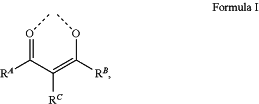| CPC H10K 85/342 (2023.02) [C07F 15/0033 (2013.01); C09K 11/06 (2013.01); C09K 2211/1029 (2013.01); C09K 2211/185 (2013.01); H10K 50/121 (2023.02); H10K 71/00 (2023.02); H10K 71/15 (2023.02); H10K 71/311 (2023.02)] | 18 Claims |
|
1. A compound having a formula Ir(LA)(LB)2, wherein LB is a bidentate ligand;
wherein LA has the structure of
 wherein:
RA is a hydrogen or a substituent selected from the group consisting of deuterium, halogen, alkyl, cycloalkyl, heteroalkyl, heterocycloalkyl, arylalkyl, alkoxy, aryloxy, amino, silyl alkenyl, cycloalkenyl, heteroalkenyl, alkynyl, aryl, heteroaryl, acyl, carboxylic acid, ether, ester, nitrile, isonitrile, sulfanyl, sulfinyl, sulfonyl, phosphino, boryl, and combinations thereof,
RB and RC are each independently a hydrogen or a substituent selected from the group consisting of deuterium, halogen, alkyl, cycloalkyl, heteroalkyl, heterocycloalkyl, alkoxy, amino, alkenyl, cycloalkenyl, heteroalkenyl, aryl, heteroaryl, acyl, ester, sulfanyl, and combinations thereof,
RA and RB cannot be concurrently alkoxy,
wherein one of the following is true:
i) RA is alkyl and RB is a hydrogen or a substituent selected from the group consisting of deuterium, halogen, cycloalkyl, heteroalkyl, heterocycloalkyl, alkoxy, amino, alkenyl, cycloalkenyl, heteroalkenyl, aryl, heteroaryl, acyl, ester, sulfanyl, and combinations thereof;
or RB is alkyl and RA is a hydrogen or a substituent selected from the group consisting of deuterium, halogen, cycloalkyl, heteroalkyl, heterocycloalkyl, arylalkyl, alkoxy, aryloxy, amino, silyl alkenyl, cycloalkenyl, heteroalkenyl, alkynyl, aryl, heteroaryl, acyl, carboxylic acid, ether, ester, nitrile, isonitrile, sulfanyl, sulfinyl, sulfonyl, phosphino, boryl, and combinations thereof; or
ii) RA and RB are different;
LA is coordinated to Ir;
Ir is coordinated to additional maximum allowable number of ligands;
wherein LB is selected from the group consisting of:
 wherein:
Y1 to Y10 are each independently selected from the group consisting of carbon and nitrogen;
Y′ is selected from the group consisting of BRe, NRe, PRe, O, S, Se, C═O, S═O, SO2, CReRf, SiReRf, and GeReRf; wherein Re and Rf can be fused or joined to form a ring;
Ra, Rb, and Rc each independently represents zero, mono, or up to a maximum allowed substitution to its associated ring;
each Ra, Rb, Rc, Re and Rf is independently hydrogen or a substituent selected from the group consisting of deuterium, halide, alkyl, cycloalkyl, heteroalkyl, arylalkyl, alkoxy, aryloxy, amino, silyl, alkenyl, cycloalkenyl, heteroalkenyl, alkynyl, aryl, heteroaryl, acyl, carbonyl, carboxylic acid, ester, nitrile, isonitrile, sulfanyl, sulfinyl, sulfonyl, phosphino, boryl, and combinations thereof; and
two adjacent substituents of Ra, Rb, and Rc can be joined to form a multidentate ligand.
|